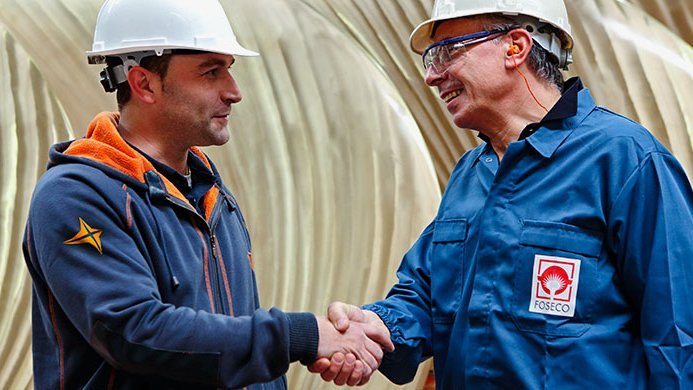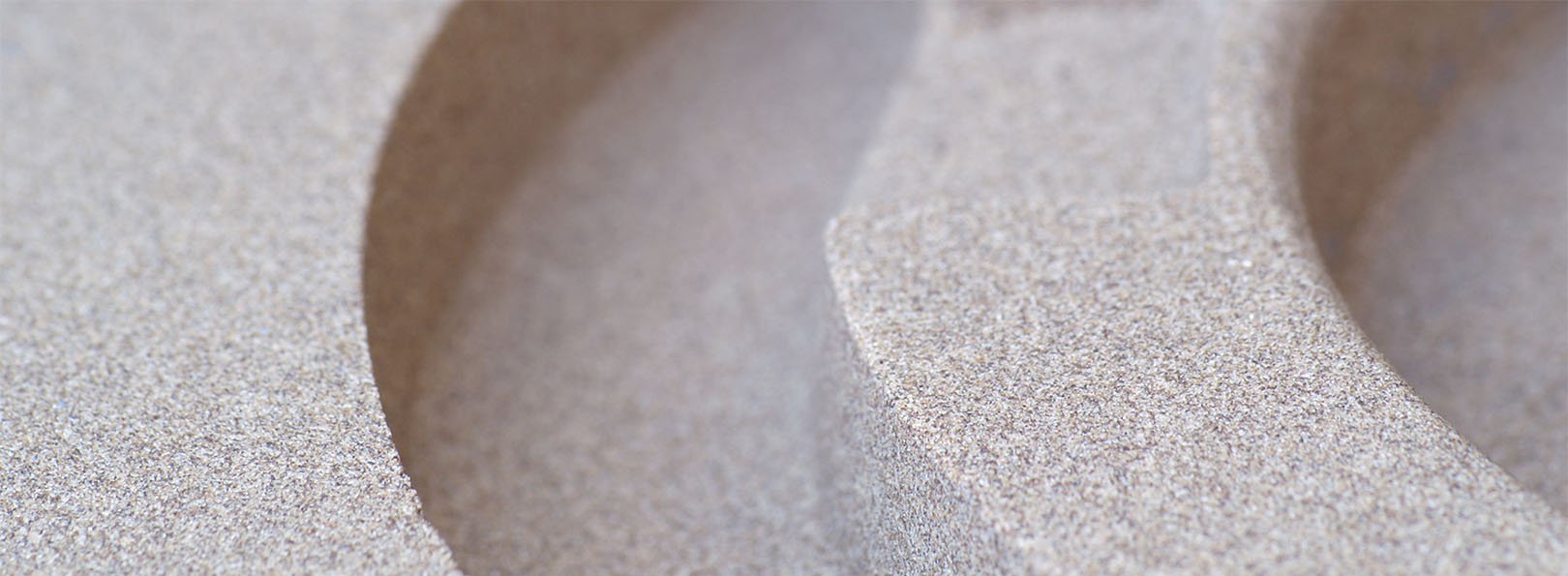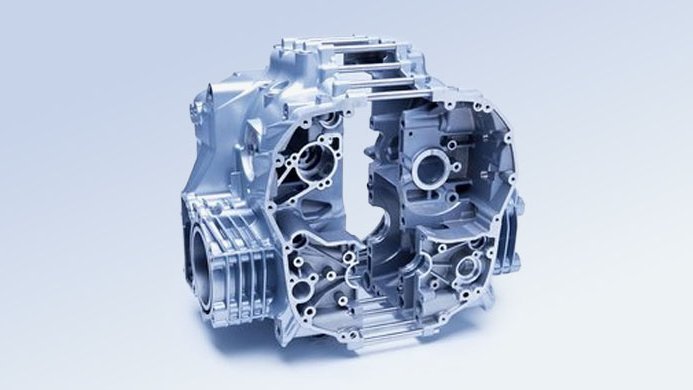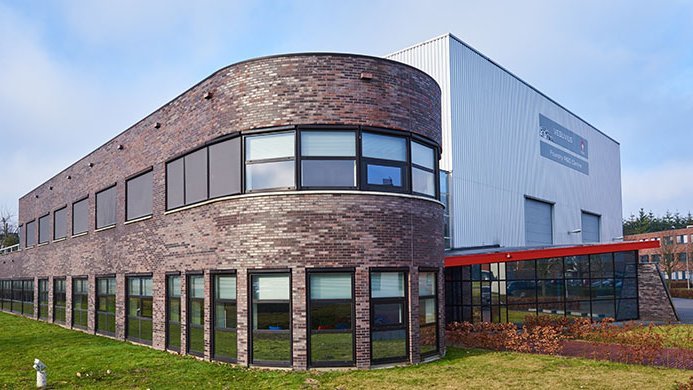

The sand casting process in modern foundries
Sand casting is a metal casting process where sand is used to form a mould into which molten metal is poured to create a part. It is a centuries-old method that remains one of the most used casting processes for both ferrous and non-ferrous alloys today. This enduring popularity is due to the flexibility and relatively low cost of sand casting — foundries use it to produce everything from engine blocks and complex machinery components to frying pans and manhole covers.
There are two primary variants of sand casting distinguished by the type of sand binder used: green sand casting (using clay and water as the binder) and chemically bonded sand casting (using chemical resin binders).
The sand casting process is highly versatile in terms of casting size, shape and production volume, making it ideal for both quick prototyping and large-scale production runs. Similarly, it is vulnerable to casting defects of different kinds. This is where Foseco comes into play: we offer modern, innovative ideas and sustainable solutions to modern foundry problems such as shrinkage in casting. Explore our range of foundry products and solutions to improve your casting processes.
How the sand casting process works
At its core, the sand casting process involves several key steps that are common to both green sand and resin-bonded sand methods:
- Pattern making & mould preparation: A reusable pattern (often made of wood, metal or resin) is created in the shape of the desired casting. This pattern is pressed into prepared sand to form the mould cavity. In green sand casting, the sand is a moist mixture of silica sand, clay (bentonite) and water that is packed or compressed around the pattern. In resin-bonded sand casting, the sand is mixed with a chemical binder (resin) and either self-hardens or is cured by an external catalyst/heat while packed against the pattern.
- Core insertion (for complex internal features): If the casting has internal cavities or undercuts, pre-formed sand cores are made and placed into the mould. These cores are usually made from resin-bonded sand (even in a green sand mould) because they often need higher strength and can be cured to hold intricate shapes. Cores may be coated with specialised refractory wash or coatings for sand moulds and cores to prevent metal penetration or sand burn-on defects during casting.
- Mould assembly & pouring: The two halves of the mould (and any cores) are assembled to close the cavity. Molten metal is then poured into a pouring basin at the top of the mould, flowing down a sprue into a system of channels (runners and gates) that lead the metal into the mould cavity. The design of the gating system is critical to ensure smooth, non-turbulent flow of metal into all parts of the mould. Foundries often incorporate feeding systems and filters at this stage to improve casting quality.
For example, exothermic feeder sleeves (risers) are positioned to feed liquid metal as the casting solidifies, which avoids shrinkage defects and improves yield. In addition, ceramic foam filters can be placed in the running system to reduce turbulence and trap inclusions, preventing re-oxidation and removing impurities from the molten metal. Using the proper combination of feeding aids and filters (such as Foseco’s STELEX® ceramic filters or HOLLOTEX® strainer cores) ensures cleaner metal and higher quality castings, with fewer defects to grind out later. - Solidification and cooling: After pouring, the filled mould is left to cool so that the metal solidifies into the shape of the cavity. As the metal solidifies, it contracts. Feeder risers compensate for this by feeding extra molten metal into the casting, solidifying last in order to prevent voids. Vents in the mould (and the natural permeability of sand) allow gases and steam to escape as the metal cools.
- Shakeout and reclamation: Once the casting has solidified and cooled sufficiently, the sand mould is broken apart to retrieve the casting. This stage is called shakeout, often done on a vibrating conveyor or knock-out station that shakes off the sand. The sand from a green sand mould is friable after casting – the water evaporates, and the clay bond is weakened by the heat – so it tends to crumble away from the casting. In resin-bonded sand moulds, the binder may not break down as easily with heat, so shakeout can be more challenging. Sometimes a release agent like Foseco’s PARTISAL is applied to mould surfaces to help the casting separate from the sand more easily during shakeout.
After shakeout, the remaining sand is processed to remove metal particles and debris. Most of the sand can be reclaimed and cooled for reuse in subsequent moulds. Green sand is routinely recycled: a portion of “burnt” sand (thermally damaged or fine particles) is removed and replaced with fresh sand and additives to keep the mixture in optimal condition. Reclaiming chemically bonded sand is more challenging than reclaiming green sand because residual resin films can coat the grains. However, modern binder technologies have significantly improved reclaimability – high reclamation rates are now possible with certain self-set and cold-set binder systems (e.g. Foseco’s FENOTEC no-bake and POLISET cold-box binders). This means foundries can recycle a large proportion of their resin sand, reducing waste and cost, as well as minimising environmental impact.
After shakeout, the raw casting goes through finishing processes (cutting off feeders, grinding, and cleaning) to produce the final component. The sand casting process, whether using green sand or resin-bonded sand, thus provides a relatively simple route from pattern to finished casting.
Advantages and disadvantages of sand casting compared to other casting methods
The sand casting process is one of the most widely used metal casting methods due to its versatility, cost-effectiveness, and ability to produce a vast range of casting sizes and complexities. However, like any manufacturing process, sand casting has its own strengths and limitations when compared to other casting methods such as investment casting, die casting, and lost-foam casting. Understanding these differences helps foundries select the most suitable method based on their production needs, material requirements, and quality expectations.
| Casting Process | Advantages | Disadvantages |
|---|---|---|
| Sand Casting | Low tooling cost, large part capability, flexible for many metals | Rougher surface finish, lower dimensional accuracy, slower production |
| Investment Casting | Superior surface finish, high precision, fine detail reproduction | High tooling cost, slow and complex process, limited part size |
| Die Casting | High-speed production, excellent surface finish, great for thin-walled parts | High tooling cost, limited to non-ferrous metals, high initial investment |
| Lost-foam casting | Higher dimensional accuracy and complex geometries, improved surface finish, fewer casting defects | Higher initial tolling and pattern production cost, limited to steel alloys and cast irons due to high pouring temperatures, longer production cycles |
Advantages of sand casting
One of the most significant advantages of sand casting is its low initial tooling cost. Compared to processes like die casting or investment casting, where permanent metal moulds or ceramic shell patterns require substantial upfront investment, sand casting uses inexpensive and reusable materials, such as silica sand, clay, and chemical binders, to create disposable moulds. This cost efficiency makes sand casting highly attractive for large or heavy castings, where the expense of manufacturing a permanent mould would be impractical.
Additionally, sand casting is compatible with almost any metal alloy, including ferrous and non-ferrous materials. Foundries commonly use this process for casting:
- Iron alloys (grey iron, ductile iron, malleable iron)
- Steel alloys (carbon steel, stainless steel, tool steel)
- Aluminium, brass, bronze, and copper alloys
- Exotic alloys such as nickel-based and titanium alloys
Other casting processes, such as die casting, are typically limited to non-ferrous metals (e.g., aluminium, zinc, and magnesium), while investment casting works best with small-to-medium parts due to mould fragility and production costs. In contrast, sand casting provides unmatched flexibility in material selection, making it ideal for custom, large-scale, or low-volume production runs across multiple industries.
Unlike many casting methods that have limitations on size, sand casting can produce components from a few grams to several tonnes. This capability makes it the preferred choice for large industrial applications, such as automotive components or heavy equipment and machinery. Sand casting is highly adaptable, making it suitable for both small-batch custom production and mass production. Foundries can rapidly create new moulds with minimal lead time, making it an excellent choice for prototype development, custom components, and replacement parts.
Unlike lost-foam casting or die casting, where a fixed mould limits flexibility, sand casting can produce one-off designs without the need for costly retooling. This makes it ideal for manufacturers needing rapid product iterations or adjustments. Furthermore, both green sand and chemically bonded sand can be recycled and reused, significantly reducing material waste. Green sand can be reconditioned by adjusting moisture and clay content, while resin-bonded sands can be thermally or mechanically reclaimed. This sustainability aspect makes sand casting an economically and environmentally viable option, particularly in high-volume foundries where material efficiency is crucial.
Disadvantages of sand casting
One of the primary disadvantages of sand casting compared to investment casting or die casting is its lower precision and rougher surface finish.
- Sand moulds, especially in green sand casting, have lower rigidity, which can lead to slight deformation of the casting, reducing dimensional accuracy.
- The granular nature of sand creates rougher surfaces (Ra ~200-500 µin) compared to die casting or investment casting, which can achieve much finer surface finishes (~50-100 µin).
For high-precision applications, additional machining and finishing operations (such as grinding, polishing, or CNC machining) may be required to meet stringent tolerances.
Additionally, sand casting has a slower production cycle compared to die casting or shell mould casting, as each mould must be prepared individually before pouring. Green sand moulds require packing and pattern removal, which adds time. Resin-bonded sand moulds need curing or setting before they can be used. After pouring, the cooling and solidification time is relatively long, particularly for large castings.
While sand casting allows for high flexibility, it is also more prone to certain casting defects compared to permanent mould processes like die casting or gravity casting. Common sand casting defects include:
- Shrinkage porosity – due to improper feeding of molten metal
- Gas porosity and air pockets – caused by trapped gases in the sand or metal
- Sand inclusion – loose sand particles getting embedded in the metal
- Metal penetration and burn-on – molten metal infiltrating the sand surface
- Veining and scabbing – thermal expansion cracks in the mould surface
To mitigate these defects, foundries rely on advanced process controls, filtration systems, riser sleeves, and mould coatings (such as those provided by Foseco) to enhance casting quality and reduce rejection rates.
Unlike die casting or investment casting, sand casting is not well-suited for extremely thin-walled parts (e.g., <2 mm thick). The lack of high-pressure filling and the relatively coarse grain structure of the sand mould limits the process’s ability to create very fine, detailed sections.
For example, die casting and investment casting excel in thin-walled components, such as electronics housings or aerospace turbine blades, where fine detail and high-strength, lightweight designs are critical.
Optimise your sand casting processes with Foseco
Whether using green sand, resin-bonded sand, or a combination of both, foundries rely on a variety of consumable products to get the best results from the sand casting process. Foseco is a leading global supplier of foundry consumables for all types of sand casting, offering an integrated range of solutions that address each stage of the process: from mould and core making through to pouring and shakeout. By partnering with a supplier like Foseco, foundries gain access to technical foundry expertise and a portfolio of proven products to enhance quality and productivity.
Foseco offers a comprehensive range of sand casting process solutions designed to enhance quality, efficiency, and defect reduction in both green sand and chemically bonded sand casting. Our binder systems, such as ESHANOL (furan), POLISET (polyurethane), and FENOTEC (alkaline phenolic), provide superior mould and core strength while minimising emissions and improving reclamation rates. To enhance surface finish and defect prevention, Foseco’s SEMCO® and HOTTOP® mould and core coatings prevent metal penetration, veining, and burn-on, ensuring smoother castings with less post-processing. For filtration and inclusion removal, STELEX® ceramic filters and SEDEX® filters ensure cleaner molten metal flow, reducing slag inclusions and turbulence. By integrating these advanced consumables, foundries can achieve higher casting quality, reduced scrap rates, and optimised production in sand casting.




